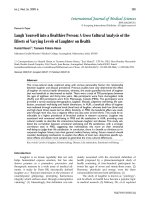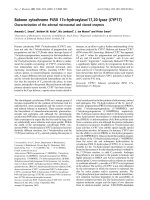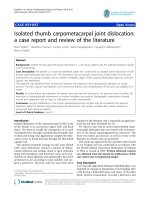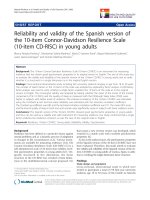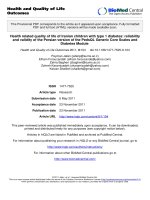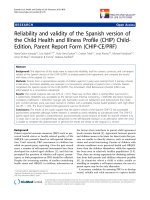Báo cáo y học: "he Alcohol Use Disorders Identification Test (AUDIT): reliability and validity of the Greek version" docx
Bạn đang xem bản rút gọn của tài liệu. Xem và tải ngay bản đầy đủ của tài liệu tại đây (188.55 KB, 5 trang )
Annals of General Psychiatry
Primary research
The Alcohol Use Disorders Identification Test (AUDIT):
reliability and validity of the Greek version
George Moussas
1
, Georgia Dadouti
2
, Athanassios Douzenis*
1
,
Evangelos Poulis
2
, Athanassios Tzelembis
3
, Dimitris Bratis
3
,
Christos Christodoulou
1
and Lefteris Lykouras
1
Address:
1
Second Psychiatry Department A thens University Medical School, Attikon Hospital, Athens , Greece,
2
Athens Psyc hiatric Hospital,
Alcohol Detoxification and Short Term Treatment Unit, Athens, Greece and
3
Psychiatric Department, Sotiria General Hospital , Athens, Greece
E-mail: George Moussas - ; Georgia Dadouti - ; Athanassios Douzenis* - ;
Evangelos Poulis - ; Athanassios Tzelembis - ; Dimitris Bratis - ;
Christos Christ odoulou - ; Left eris Lykouras -
*Corresponding author
Published: 14 May 2009 Received: 3 October 2 008
Annals of General Psychiatry 2009, 8:11 doi: 10.1186/1744-859X-8-11
Accepted: 14 May 2009
This article is available from: />© 2009 Moussas et al.; licensee BioMed Central Ltd.
This is an open acces s article dist ributed under the terms of the Creative Commons Attribution License (
/>which permits unrestricted use, distribution, and reproduction in any medium, provided the original work is properly cited.
Abstract
Background: Problems associated with alcohol abuse are recogni sed by the World Health
Organization as a major heal th issue, which according to most recent estimations is responsible for
1.4% of the total world burden of morbidity and has been proven to increase mortality risk by 50%.
Because of the size and sever ity of the problem, early detection is very important. This requires
easy to use and specific tools. One of these is the Alcohol Use Disorders Identification Test
(AUDIT).
Aim: This study a ims to standardise the questionn aire in a Greek population.
Methods: AUDIT was translated and back-translated from its original language by two English-
speaking psychiatrists. Th e tool contains 10 questions. A score ≥ 11 is an indication of serious
abuse/dependence. In the study, 218 subjects took part: 128 were males and 90 females. The
average age was 40.71 years (± 11.34). From the 218 individuals, 109 (7 5 male, 34 female) fulfilled
the criteria for alcohol dependence according to the Diagnostic and Statistical Manual of Mental
Disorders, 4th edition (DSM-IV), and presented requesting admission; 109 subjects (53 male, 56
female) were healthy controls.
Results: Internal reliability (Cronbach a)was0.80forthecontrolsand0.80forthealcohol-
dependent indivi duals. Controls had significantl y lower average scores (t test P < 0.001) when
compared to the alcoholics. The questionnaire's sensitivity for scores >8 was 0.98 and its specificity
was 0.94 for the same score. For the alcohol-dependent sample 3% scored as false negatives and
from the control group 1.8% scored false positives. In the alcohol-dependent sample there was no
difference between males and females in their average scores (t test P > 0.05).
Conclusion: The Greek version of AUDIT has increased internal reliability and validity. It detects
97% of the alco hol -dependent individuals and has a hi gh sensitivity and specificity. AUDIT is easy to
use, quick and rel iable and can be very useful in detection alcohol problems in sensitive populations.
Page 1 of 5
(page number not for citation purposes)
BioMed Central
Open Access
Introduction
Problems associated with alcohol abuse are recognised
by the World Health Organization (WHO) as a major
health issue, which according to most recent estimations
is responsibl e for 1.4% of the total world burde n of
morbidity [1]. In the US alone, 8 million individuals
aged 18 o r more fulfil Diagnostic and Statistical Manual
of Mental Disorders, 4th edition (DSM-IV) criteria for
alcohol addiction [2]. Alcohol addiction incidence varies
from 1% t o 5% according to WHO for developed and
developing countries (including Greece) [3 -5]. The
financial cost of alcohol addiction at the level of health
loss, social and financial burden is so big that alcohol
addiction has become a public health priori ty [6].
Overall, in Europe alcohol abuse and addiction is held
responsible for 1.8 million deaths (that is, 3.2% of the
total causes of mortality) and 58.3 million (4%) of the
total of life years in incapacity [7]. In Greece, epidemiol-
ogy of alcohol use has shown changes fr om the
traditional way of drinking alcohol and according to a
2004 study, the average consumption is 11.39 litres per
capita; this gives Greece 10th position amongst the 26
European countries, with the index of harmful use being
2 [8]. There is also evidence showing that alcohol
consumption is very common in Greece, since 1 in 4
adults drinks often (at least 10 times in the last month)
and that excessive alcohol consumption (5 or more
drinks at every session during the last month) happens 1
time in 10. This type of consumption (binge drinking) is
very common in young adults (18 to 24 years old), with
male predominance (1:5 ) [ 9].
Because of the importance of alcohol abuse/addiction in
public health and its association with a wide spectrum of
medical, social and psychological problems, early detec-
tion at the onset of abuse is very i mportant. This r equires
specific tools to help di agnosis such as CAGE (named for
an acronym of its four questions) and the Alcohol Use
Disorders Identification Test (AUDIT) [10]. The aim of
this study is to validate AUDIT in a Greek population.
AUDIT detects alcohol abuse/addiction and is used in
many studies as well as being a screening instrument for
specific populations. AUDIT was created by a working
group of the WHO by choosing questions that dis-
criminate high risk drinkers in a six nations study [11].
Materials and methods
AUDIT consists of 10 questions scored individually from
0 to 4. A total score of >8 is an indication of alcohol
abuse, a score of >15 indicates serious abuse/addiction
whilst a score between 8 a nd 10 is an indication of being
at risk, according to the authors [10,11]. The question-
naire contains 10 questions; three questions on use, four
on dependence and three questions about problems
relatedtouse.
AUDIT was translated in Greek from the English original
by bilingual psychiatrists and back-translated from Greek
to English by another bilingual psychiatrist.
A total of 218 subjects took part (1 28 males, 90 females).
Of them, 109 subjects (75 males and 34 females) fulfilled
DSM-IV criteria for alcohol addiction and were recruited
from alcohol treatment units. The questionnaire was
completed by care workers and psychiatrists with long
experience in administering psychiatric rating scales.
Average daily alcohol consumption of the alcohol-
addicted subjects was 250 g during the last 6 months.
All had a history of addiction of 5 years or m ore.
A further 109 individuals (53 males, 56 females) were
used as healthy controls. These had no physical or
psychiatric disorder and did not fulfil the DSM-IV criteria
for alcohol addiction. Controls were recruited from
hospital medical and nursing staff, teachers and manual
workers. Data on sex, age and family status were collected.
The average age of the sample was 40.71 (± 11.34). In
all, 39.1% were unmarried and 14.7% separated.
Results
Reliability of internal consistency (Cronbach a index)
was 0.7288 for the controls and 0.7989 for the patients
(Table 1). Omitting the first ques tio n increased the
Cronbach a index, but this increase was small and
changes to the questionnaire were not required (Table 1).
There was no statistically significant age difference
between the alcoholic sample and the controls.
The healthy controls had significantly lower average
scores in the questionnaire 3.8 (± 3.61) (t test P < 0.001)
when compared to the average scores of alcohol-
dependent individuals (26.69 (± 8.39) ; Table 2).
Controls scored lower average scores in all 10 questions
of the AUDIT questionnaire (Table 3).
The questionnaire's sensitivity calculated for answers ≥ 8
was 0.98 (107/109) and its specificity 0.94 (101/109).
In the control sample, males had a higher average AUDIT
score (t test P < 0.001) when compared to females
(5.02±4.10vs2.64±2.62)(Table4).However,inthe
sample of alcohol-dependent individuals there is no
difference between male and female average AUDIT score
(males 26.36 ± 8.57 vs 27.41 ± 8.06 females) (Table 5).
AgehadanegativecorrelationwithAUDITscorein
the alcohol-dependent population (Pearson's P < 0.005,
r = -221). Family status did not appear to influence the
questionnaire in both alcoholic subjects and controls
(ANOVA P > 0.005).
Annals of General Psychiatry 2009, 8:11 />Page 2 of 5
(page number not for citation purposes)
Discussion
AUDIT has a high level of in ternal consistency and high
reliability and validity in relation to clinical diagnosis. It
detects 97% of patients and with a cut-off point set at 10
points has high sensitivity and specificity. There is no
need to alter the cut-off point in relation to gender and
the higher scores associated with male sex in the control
population can be attributed to other parameters.
Patients addicted to alcohol and other psychoactive
substances have a wide range of needs that should be
addressed if hea lth services aim to provide the le vel of
care needed [10]. The appropriate care should be based
on prevention/education, recognition/detection, treat-
ment [11,12] and follow-up.
Prevention of the physical and psychiatric complications
of alcohol abuse/addiction is one of the main pillars on
Table 1: Alcoh ol Use Disorders Identification Test (AUDIT) reliability analys is (Cronbach a)
AUDIT questions Control group (no of cases = 109) Alcoholics group (no of cases = 109)
Corrected item/
total correlation
a if item
deleted
Corrected item/
total correlation
a if item
deleted
How often do you have a drink containing alcohol? 0.344 0.8096 0.1844 0.8052
How many drinks containing alcohol do you have on a typical day
when you are drinking?
0.4342 0.7664 0.5902 0.7698
How often do you have six or more drinks on one occasion? 0.5118 0.7562 0.5832 0.7705
How often during the last year have you found that you were not able
to stop drinking once you had started?
0.5841 0.753 0.6739 0.7565
How often during the last year have you failed to do what was
normally expected from you because of drinking?
0.4719 0.7657 0.5771 0.768
How often during the last year have you needed a first drink in the
morning to get yourself going after a heavy drinking session?
0.5993 0.7605 0.4724 0.7835
How often during the last year have you had a feeling of guilt or
remorse after drinking?
0.5536 0.7583 0.5076 0.7771
How often during the last year have you been unable to remember
what happened the night before because you had been drinking?
0.7058 0.7509 0.5588 0.7709
Have you or someone else been injured as a result of your drinking? 0.3985 0.7739 0.2828 0.807
Has a relative or friend or a doctor or another health worker been
concerned about your drinking or suggested you cut down?
0.5245 0.7543 0.3183 0.7974
Reliability coefficient (N = 10) a = 0.7828 a = 0.7989
Table 2: Mean of age and Alcohol Use Disorders Identification
Test (AUDIT)
Age AUDIT
Control group Mean 39.66 3.79
N 109 109
SD 12.80 3.60
Alcoholic group Mean 41.75 26.68
N 109 109
SD 9.61 8.39
Total Mean 40.71 15.24
N 218 218
SD 11.34 13.15
SD, standard deviation.
Table 3: Means of Alcohol Use Disorders Identification Test
(AUDIT) questions (Q) between alc oholic and control group
N Mean Standard
deviation
AUDIT Q1 Alcoholic group
Control group
109
109
3.59
2.24
7.83
1.08
AUDIT Q2 Alcoholic group
Control group
109
109
2.90
3.21
1.22
5.59
AUDIT Q3 Alcoholic group
Control group
109
109
3.22
3.67
1.22
6.47
AUDIT Q4 Alcoholic group
Control group
109
109
3.02
1101
1.44
4.78
AUDIT Q5 Alcoholic group
Control group
109
109
2.19
7.339E-02
1.55
4.24
AUDIT Q6 Alcoholic group
Control group
109
109
1.85
6.422E-02
1.75
3.40
AUDIT Q7 Alcoholic group
Control group
109
109
2.94
1.28
1.48
4.3
AUDIT Q8 Alcoholic group
Control group
109
109
2.27
8.257E-02
1.45
3.63
AUDIT Q9 Alcoholic group
Control group
109
109
1.45
2.38
1.63
7.56
AUDIT Q10 Alcoholic group
Control group
109
109
3.21
1.65
1.26
7.26
Table 4: Sex and Alcohol Use Diso rders Identification Test
(AUDIT) score in controls
Mean N Standard deviation
Male 5.018* 53 4.10
Female 2.642* 56 2.61
Total 3.798 109 3.60
*Student t test P <0.01.
Annals of General Psychiatry 2009, 8:11 />Page 3 of 5
(page number not for citation purposes)
which care should be based, and this is closely associated
with early detect ion/recognition of problem-drinkers.
On the issue of early diagnosis, AUDIT can offer
substantial help since it is quick and easy to use as
well as reliable. AUDIT can be of help in screening
populations at risk and patients with comorbid mental
disorders [13]. This comorbidity can include schizo-
phrenic disorders, mood disorders, personality disorders
and other major psychiatric disorders [14,15].
AUDIT can also be used in Emergency Departments in
order to aid differential diagnosis between psychotic
symptoms or symptoms induced by alcohol abuse and
addiction, since it i s established that alcohol problems
are underdiagnosed in psychiatric emergency assess-
ments [13,16]. Using AUDIT cou ld help in the scr eening
of patients present ing to General Hospitals and prompt
referral to psychiatric services and alcohol units [16].
Thiswouldleadtoimprovedoutcomes,sincelate
detection of abuse/addiction is associated with poor
therapeutic outcomes. This is the case not only regarding
alcohol addiction but for concomitant physical illness as
well [17]. Additionally, it is established that alcohol
addiction is comorbid with psychosis, anxiety, emo-
tional and personality disorders as well as attention
deficit disorder and hyperactivity [18].
AUDIT is a reliable and sensitive instrument and is
widely used in Europe and the rest of the world. It has
been translated into many languages. It is used not only
in prim ary care but in inpatient settings as well [19-22 ].
Conclusion
Alcohol abuse/dependence, apart from being a major
health issue, is also related to a wide spectrum of
medical, psychiatric and soci al problems. Early detection
and diagnosis is vital for prevention and treatment of
these alcohol related problems. Early detection is not an
easy task. Patients often have difficulties in admitting the
level of their daily alcohol consumption. Using ques-
tionnaires that can detect covert forms of alcohol
addiction is very important. AUDIT, having been
validated in a Greek population, can now be used by
teams and programs working in the field of alcohol
addiction as it has been proven to be a useful and
reliable in strume nt.
Competing interests
The authors declare that they have no competing
interests.
Authors' contributions
GM and GD designed the stud y. GM and AD wr ote the
paper. EP, AT, DB, CC collected the data and statistically
analysed them. LL had the overall supervision of the
study.
References
1. World Health Organization: The World Health Report. Geneva,
Switzerland: World Health Organization; 2003.
2. American Psychiatric Association: Diagnostic and Statistical
Manual of Mental Disorders. Washington, DC: American
Psychiatric Association; 41994.
3. Dawson DA: Alcohol consumption, alcohol depen dence, and
all-cau se mortality. Epidemiology and prevention. Alcohol Clin
Exp Res 2000, 24(1):72–81.
4. Grant BF, Hanson DS, Stinson FS, Dawson DA, Chou SP, Ruan WJ
and Pickering RP: Prevalence, correlates and disability of
personality disorder in the United States : results from the
national epidemiologic survey on alcohol and related
conditions. J Cli n Psychiatry 2004, 65(7):948–58.
5. World Health Organization: Global status report on alcohol
2004.Geneva, S witzerland: World Health Organization; 2004.
6. Dawson DA, Grand BF, Stinson FS and Chou PS: Estimating the
effect of help-seeking on achieving recovery from alcoho l
dependence. Addiction 2006, 101(6):824–834.
7. World Health Organization: Alcohol in the European region –
consumption, harm and policies.Geneva, Switzerland: WHO
Regiona l office for Europ e; 2001.
8. Reh m J, Room R, Brink Van den W and Jacobi F: Alcohol use
disorders in EU countries and Norway: an overview of
the epidemiology. European Neuropsychopharmacology 2005,
15:377–388.
9. Kitsos G, Kontogeorgiou K, Bafi I, Karahaliou K and Kokkevi A:
Alc oholic beverages: Use and addiction. Annual Report for Dru gs
and Alcohol 2005 Athens, Greece: EKTEPN, EPIPSY; 2006.
10. Saunders JB, Aasland OG, Babor TF, de la Fuente JR and Grand M:
Dev elopment of the Alcohol Use Disorders Identification
Test (AUDIT): WHO collaborative project on early detec-
tion of persons with harmful alcohol consumption – II.
Addiction 1993, 88(6):791–804.
11. Babor TF, Higgins-Biddle JC, Saunders JB and Monteiro M: AUDIT –
the Alcohol Use Disorder Identification Test: guidelines for
use in primary health care.Geneva, Switzerland: World Health
Org anization, Department of Mental Health and Substance Abuse;
22001, WHO/MSD/MSB/01.6a.
12. Garnick DW, Horgan CM and Chalk M: Performance measures
for alcohol and other drug services. Alcohol Res Health 2006,
29(1):19–26.
13. Kessler RC, Crum RM, Warner LA, Nelson CB, Schulenberg J and
Anthony JC: Lifetime co-occurrence of DSM-III-R alcohol
abuse and dependence with other psychiatric disorders in
the National Comorbidity Survey. Arch Gen Psychiatry 1997,
54(4):313
–21.
14. Dervaux A, Bayle FJ, Laqueille X, Bourdel M-C, Leborgne M, Olie J-P
and Krebs M-O: Validity of the CAGE questionnaire in
schizophren ic patients with alcohol abu se and dependence.
Schizophrenia Res 2006, 81(2–3):151–155.
15. Bowden-Jones O, Iqbal MZ, Tyrer P, Seivewrit N, Cooper S, Judd A
and Weaver T: Prevalence of personality disorder in alcohol
and drug services and associated comorbidity. Addiction 2004,
99:1306–1314.
16. Foster J and Heather N: Brief interve ntions for alcohol
problems in hospital settings. Nurs Times 2005, 101(26) :38–41.
17. Monras M, Mondon S, Ortega L and Gual A: Alcoholism in the
gen eral hospital: 4 years mortality and hospitalization. Med
Clin (Barc) 2005, 125(12):441–447.
Table 5: Sex and Alcohol Use Disorders Identification Test
(AUDIT) score in alcoholic gr oup
Mean N Standard deviation
Male 26.36* 75 8.56
Female 27.41* 34 8.00
Total 26.68 109 8.39
*Student t test P > 0.05.
Annals of General Psychiatry 2009, 8:11 />Page 4 of 5
(page number not for citation purposes)
18. Brady KT, Verduin ML and Tolliver BK: Treatment of patients
comorbid for addiction and other psychi atrc disorders. Cur r
Psychiatry Rep 2007, 9(5):374–380.
19. Gache P, Michaud P, Laundry U, Accieto C, Arfaoui S, Wenger O and
Daeppen JB: The Alcohol Use Identification Test (AUDIT) as
a screening tool for excessive drinking in primary care:
reliability and validi ty of a french version. Alcohol Clin Exp Res
2005, 29(11):2001–2007.
20. Gomez Arnaiz A, Conde Martela A, Alberto Aquiar Bautista J,
Manuel Sa ntana Montesdeoca J, Jorrin M oreno A and Betancor
Leon P: Diagnostic usefulness of Alcohol Use Disorders
Identification Test (AUD IT) for detecting hazardous alcohol
consumption in primary care settings. MedClin(Barc)2001,
116(4):136–7.
21. Conde Martel A, Gomez Arnaiz A, Aquiar Bautista JA, Santana
Montesdeoca JM, Jorrin Moreno A and Suarez Ortega S: Diagnostic
usefulness of the questionnaire "Alcohol Use Disorders
Identification Test" (AUDIT) to detect condit ions asso-
ciated with alcohol in hospitalized patients. An Med Interna
2000, 17(11):576–81.
22. Conigrave KM, Saunders JB and Reznik RB: Predictiv e capacity of
the AUDIT questionnaire for alcohol-related harm. Addiction
1995, 90(11):1479–1485.
Publish with Bio Med Central and every
scientist can read your work free of charge
"BioMed Central will be the most significant development for
disseminating the results of biomedical researc h in our lifetime."
Sir Paul Nurse, Cancer Research UK
Your research papers will be:
available free of charge to the entire biomedical community
peer reviewed and published immediately upon acceptance
cited in PubMed and archived on PubMed Central
yours — you keep the copyright
Submit your manuscript here:
/>BioMedcentral
Annals of General Psychiatry 2009, 8:11 />Page 5 of 5
(page number not for citation purposes)
